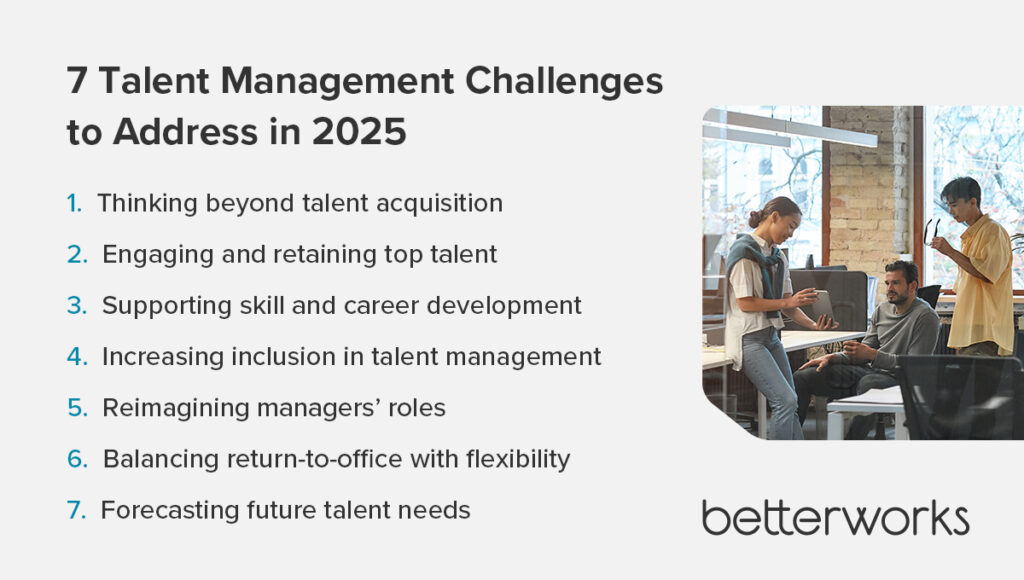The race for top talent is fiercer than ever, but today’s talent management challenges aren’t just about hiring the right people. You’re tasked with engaging your workforce, developing their skills, and preparing them for an AI-driven future.
Companies that fail to adapt risk losing their best employees to more forward-thinking competitors. According to Betterworks’ 2025 State of Performance Enablement report, 78% of high performers are actively seeking new opportunities—often with companies prioritizing AI innovation and workforce adaptability.
If your talent strategy isn’t evolving, your best employees may already have one foot out the door. Discover some of the challenges of talent management and the steps you can take to overcome them.

Thinking beyond talent acquisition
With a dwindling talent pool and a challenging labor market, talent acquisition alone isn’t a viable path to filling open roles. Instead, you need a strategy to keep the employees you already have engaged, growing, and aligned with long-term business goals. Failing to invest in internal growth, on the other hand, leads to widening skills gaps, longer hiring cycles, and higher turnover. Without effective talent mapping, you risk overlooking employees who could step into leadership roles or specialized positions, forcing you into costly external searches.
A structured approach to talent development and skills management prepares you to address talent challenges and offer employees clear career paths within the business. By prioritizing internal mobility and strategic workforce planning, you can improve retention and future-proof your workforce—all while ensuring the right talent is in place when you need it most. AI-driven talent management systems can help you identify high-potential employees, align them with the right development opportunities, and close skills gaps before they impact performance.
Engaging and retaining top talent
Employees need to see that they can grow and build the careers they want within your organization. Lack of structured talent development, unclear career paths, and limited growth opportunities push top performers to look elsewhere. Factors like work-life balance, remote work flexibility, and a culture of recognition also play a major role in whether employees stay or leave.
AI adoption poses a new retention challenge — or an opportunity. The employees most likely to show interest in or engage with AI tools are also most likely to leave, we found in our 2025 State of Performance Enablement report. Proactively training employees to use AI can open new avenues for growth, encouraging your most innovative talent to stay put.
When retention suffers, so does the business. High turnover increases hiring costs, disrupts operations, and weakens morale, creating a cycle that’s difficult to break. To retain top talent, you need a clear development strategy, regular feedback loops, and pathways for advancement that align employee goals with business needs.
Regular career conversations, mentorship programs, and leadership development initiatives help employees see long-term potential within your organization. AI-enabled performance management systems can support these efforts by identifying at-risk employees, tracking engagement trends, and offering personalized development plans—helping you address issues before they lead to turnover.
Supporting skill and career development
How we work is evolving fast, and employees need ongoing skill development to keep pace. Without clear career growth opportunities, even top performers can become disengaged, stalling both their progress and your company’s success. However, the challenges of skills development abound, starting with even identifying where skills gaps exist. Most organizations (69%) rely on performance evaluations to assess skills but only conduct these reviews 1-2 times a year, our 2024 Skills Fitness report found, making it hard to get a clear picture of workforce skills.
In this climate, traditional upskilling approaches aren’t enough — changing job roles, technological advancements, and increasing demand for specialized skills require a more dynamic strategy. A strong development plan that includes structured learning, mentorship, and well-defined career pathways can help close skills gaps and keep employees engaged.
AI-powered talent profiles can help by aggregating skills data, identifying skill gaps, and suggesting ways to apply skills in the flow of work. By integrating skill development into daily work, you can create a culture where employees continuously grow—and you can attract and retain top talent.
Increasing inclusion in talent management
Driving inclusion goes beyond policies—it requires building a workplace where every employee has a fair shot at growth and success. Many organizations have taken steps to address unconscious bias, yet hiring, performance reviews, promotions, and learning opportunities often still favor some employees over others. When talent development isn’t equitable, opportunities aren’t either.
Without an inclusive talent management framework, you risk losing top talent, weakening innovation, and damaging your reputation. If employees don’t see a future for themselves in your company, they will look elsewhere.
To get it right, you need clear career pathways, objective performance criteria, and leadership accountability. AI-powered tools can help by flagging biases, tracking diversity metrics, and ensuring career development is based on verified skills rather than subjective evaluations. But AI alone won’t fix the problem: True inclusion happens when leadership commits to backing data with action and creating a workplace where talent thrives—no matter where team members come from.
Reimagining managers’ roles
Middle managers keep your organization running, but they’re running on empty. Most HR leaders (75%) recognize that managers are overwhelmed, and 70% acknowledge that their leadership programs aren’t helping managers fill the gaps, according to Gartner’s 2025 HR Priorities Survey. Burnout is rising, responsibilities are piling up, and many don’t have the resources they need to support their teams.
Managers are being pulled in too many different directions and often don’t have time for professional development planning, performance conversations, or mentorship. This means team members miss out on the support they need to grow. When they’re stretched too thin, engagement suffers for both them and their teams, leading to talent development challenges.
To fix this, rethink how you equip managers for success. Better training, clearer expectations, and fewer administrative burdens are key to helping them focus on what matters most: their people. AI-driven performance management tools can support this by prompting check-ins, surfacing real-time performance insights, and coaching them to provide more actionable, effective feedback.
Balancing return-to-office with flexibility
Return-to-office (RTO) policies are putting employers and employees at odds, and it’s costing many employers valuable talent. Half of employees (51%) say they would quit if their employer reinstated a non-negotiable return to office, according to MyPerfectResume’s Remote Work Divide Report.
Leaders want in-person collaboration and a strong company culture, but employees now expect workforce flexibility as a given, not a perk. When organizations take a rigid approach to RTO, they risk alienating top talent. But when they make quiet exceptions for high performers to keep top talent happy, they create hybrid hierarchies that breed resentment.
Handled poorly, RTO policies weaken engagement, fuel turnover, and make it harder to attract talent. Employees don’t just want flexibility—they want fairness. The real challenge isn’t deciding between remote or in-office work; it’s ensuring consistent, outcome-driven policies that support both business goals and employee expectations.
The best way forward is to shift the focus from location to results. Train managers to track productivity, collaboration, and engagement metrics rather than time spent in an office.
Forecasting future talent needs
Change is happening faster than ever, and you can’t afford to wait to react. Without a forward-looking talent strategy, workforce planning becomes guesswork, leadership pipelines stall, and retention takes a hit. Yet too often, HR operates in isolation, disconnected from broader business objectives. When your talent management strategy isn’t aligned with company goals, leadership sees HR as a support function rather than a strategic force.
To change this, you need clear data-driven insights to anticipate workforce needs, identify high-potential employees, and ensure leadership continuity. A strong talent management framework should help you forecast skills gaps, succession risks, and hiring demands—not just react to them.
AI-powered workforce analytics can support your efforts by offering real-time visibility into talent trends, employee potential, and organizational gaps. Predictive modeling helps you get ahead of critical talent shortages, optimize internal mobility, and build a workforce that’s ready for what’s next.
Moving beyond talent management challenges in 2025
The challenges of talent management systems in 2025 are complex, but not insurmountable. With the right integrated talent management solutions, you can streamline talent acquisition, skills development, employee engagement, and workforce planning to build a resilient and future-ready organization.
AI-powered talent management frameworks are transforming how HR leaders attract, retain, and develop employees. By leveraging AI for talent mapping, learning and development, performance management, and DEI initiatives, you can create a work environment that supports both business goals and employee growth.
It’s time for a proactive approach. Invest in AI-powered talent strategies that support long-term success and give your workforce the tools they need to grow. Your employees—and your bottom line—will thank you.
How can you transform talent with AI?


